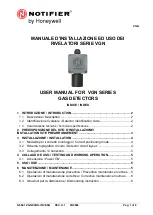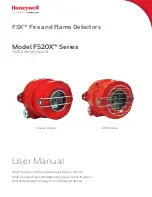
2
D-305551 MCT-442 Installation Instructions
3. PREPARATIONS
3.1 Disassembly
BRACKET
DETECTOR
1
Hold the
bracket with
one hand
2
Rotate the
detector as
shown and
pull it from
the bracket
Figure 2.
Separating the Detector from Its Bracket
3.2 Communication Format Selection
Select the desired communication format, EN or UL, by switch 1 (see
figure 3).
Note:
Switch 2 is not used.
3.3 Enrolling the Detector ID
Insert battery (see figure 3).
Battery cover
Function selector:
Sw. 1 ON = UL
Sw. 1 OFF = EN
9 volts
Open battery cover and
connect the battery to its
terminals (without insulator).
Ve ri f y pr op e r p ol ar i t y.
Tamper switch
actuator
Tab (1 of 4)
Red button
Figure 3.
Detector Rear Side
The ID of the detector's transmitter must be enrolled in the alarm control
panel memory. Refer to the alarm control panel’s installation
instructions and follow the procedure given there for enrolling detector's
transmitter ID in the control panel's memory.
When you are required to initiate a transmission for enrollment, press
the tamper switch (see fig. 3).
Note:
It is much easier to carry out this operation while holding the
detector in your hand, close to the control panel.
4. INSTALLATION
4.1 Mounting
The detector can be mounted on a wall or ceiling. For EN approved
sites, only ceiling installation is allowed.
It must be mounted with its bracket (when it is attached to its bracket
the tamper switch is pressed and the detector automatic reset is
performed).
!
Warnings
•
Installation must be performed by a qualified individual. Failure to
properly install, test and maintain a CO detector may cause it to
fail, resulting in loss of life!
•
Installation of the CO detector should not be used as a substitute for
proper installation, use and maintenance of fuel burning appliances,
including appropriate ventilation and exhaust systems.
•
Unauthorized removal of the unit from the bracket will initiate a
tamper alert!
!
Warning -
The battery must be inserted into the
detector otherwise you will not be able to close the detector.
4.2 Test
A. Local Test
Press the test button (see fig. 1) until the built-in buzzer sounds 1
beep and the red, green and yellow LEDs flash sequentially (see
section 2 - SPECIFICATION). This means that the local test is
successful. If additional or other signals exist, refer to section 2 -
SPECIFICATION.
!
WARNING:
The test switch is the only proper way to test the CO
detector. Never use vehicle exhaust! Exhaust may cause permanent
damage and void your warranty.
B. Communication Test
Create a tamper alarm at the installation location and verify that
tamper message is received by the control panel / receiver.
1
Locate the bracket on
mounting surface so
that the word “UP” is
located as shown (so
that the detectors
stickers text will be
easily readable)
Mark and drill 2 holes in
mounting surface. Fasten
the bracket to the mounting
surface with 2 screws.
Align detector’s tabs (see figure 3) with the bracket
slots and rotate the detector as shown. Pull the
detector outward to verify that it is securely attached.
2
3
UP
Figure 4.
Mounting
5. MAINTENANCE
!
Warning:
Press the detector's TEST button once every
week to ensure proper operation of the detector.
When low battery alarm exists (see specifications) immediately
replace the battery (see figure 3).
Once a month, use vacuum cleaner to clean the air vents
occasionally, to keep them free of dust.
APPENDICES
Appendix A - CO Detector Installation Overview
A-1. Selecting Installation Location
Selecting a suitable location is critical for the CO detector. The
Consumer Product Safety Commission (CPSC) recommends to use
at least one CO detector per household, located near as possible to
sleeping area of the home, because the human body is most
vulnerable to the CO gas effect during sleeping hours.
For added protection, install additional CO detector in every separate
bedroom and on every level of your home. If your bedroom hallway is
longer than 14 meters (40 feet), install a CO detector at BOTH ends of the
hallway. Install an additional detector 6 meters (20 feet) away from the
furnace or fuel burning heat source.
For
maximum
protection,
the
detector should be
also
located
outside
primary
sleeping areas or
at each level of
your home. Mount
the detector on a
firm wall or ceiling
(see par. 4.1).
BEDROOM
BEDROOM
BEDROOM
LIVING
ROOM
KITCHEN
BASEMENT
GARAGE
CO DETECTOR
Figure 5.
CO Detectors locations in a Multi-
Floor Residence





















